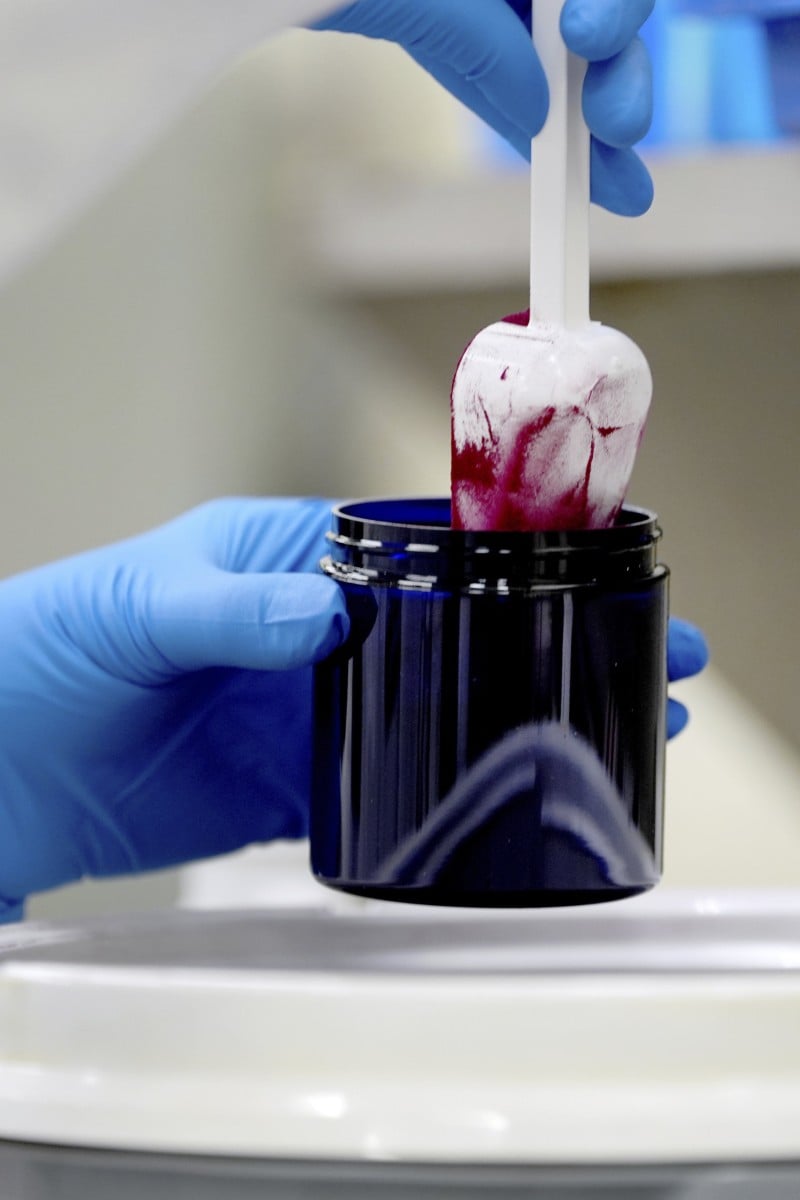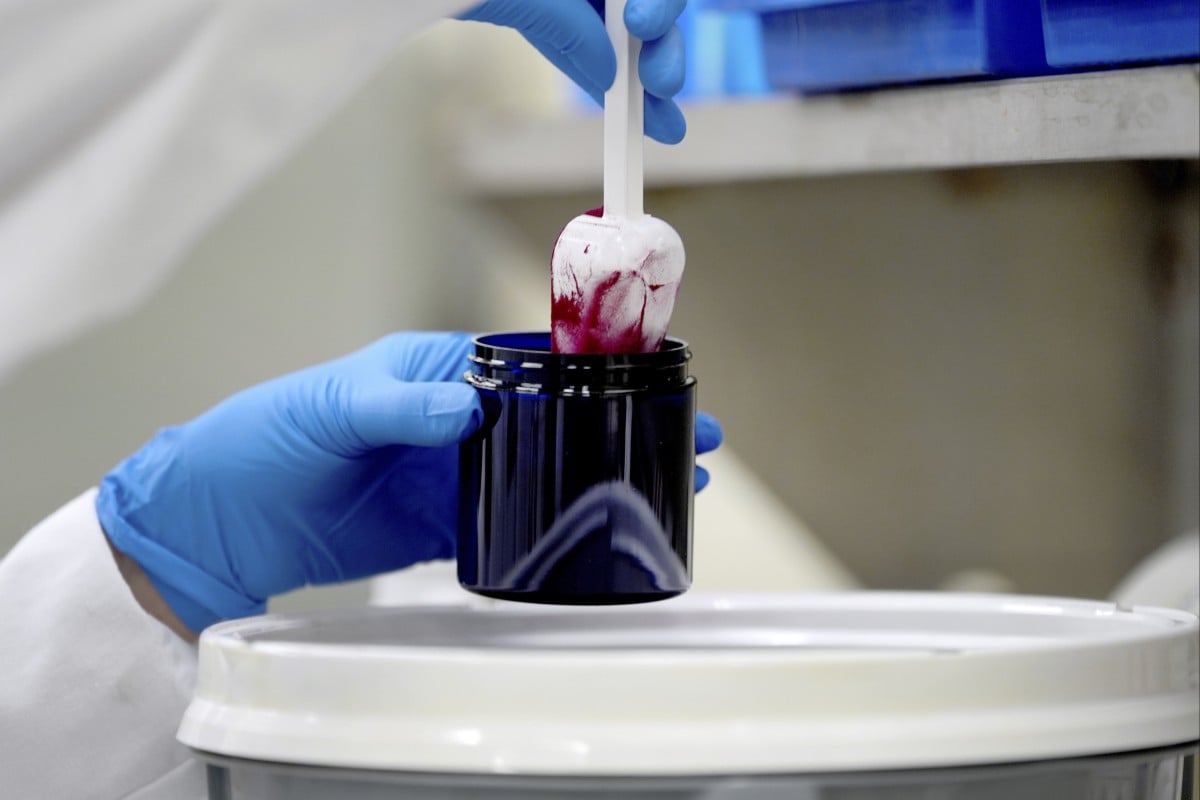
How bugs and beetroot juice could play roles in the race to replace artificial dyes in food
The demand to get artificial colours out of the United States food supply is growing, with pressure mounting from health officials and influencers
 Technician Heather Browning packages a colour sample made of beetroot powder for a customer at Sensient Technologies Corp, a colour additive manufacturing company in the US. Photo: AP
Technician Heather Browning packages a colour sample made of beetroot powder for a customer at Sensient Technologies Corp, a colour additive manufacturing company in the US. Photo: APScientist Abby Tampow hovered over tiny dishes of red dye, each a slightly different ruby hue. Her task? To match the synthetic shade used for years in a commercial bottled raspberry dressing – but using only natural ingredients.
“With this red, it needs a little more orange,” Tampow said, mixing a slurry of purplish black carrot juice with a bit of beta-carotene, an orange-red colour made from algae.
Tampow is part of the team at Sensient Technologies Corp – one of the world’s largest dye makers – rushing to help a salad dressing manufacturer and thousands of other American businesses meet demands to overhaul colours used to brighten products from cereals to sports drinks.
Last week, United States health officials announced plans to persuade food companies to voluntarily eliminate petroleum-based artificial dyes by the end of 2026.
US Health Secretary Robert F. Kennedy Jnr called them “poisonous compounds” that endanger children’s health and development, citing limited evidence of potential health risks.
The federal push follows a flurry of state laws and a January decision to ban the artificial dye known as Red 3 – found in cakes, candies and some medications – because of cancer risks in lab animals. Social media influencers and ordinary consumers have ramped up calls for artificial colours to be removed from foods.
Why we waste food when we know it’s wrong – and how to change our habits
The switch to natural colours may not come quickly
The US Food and Drug Administration (FDA) allows about three dozen colour additives, including eight remaining synthetic dyes. But making the change from petroleum-based dyes to colours derived from vegetables, fruits, flowers and even insects will not be easy, fast or cheap, said Monica Giusti, an Ohio State University food colour expert.
“Study after study has shown that if all companies were to remove synthetic colours from their formulations, the supply of the natural alternatives would not be enough,” Giusti said. “We are not ready.”
It can take six months to a year to convert a single product from a synthetic dye to a natural one. And it could require three to four years to build up the supply of botanical products necessary for an industry-wide shift, Sensient officials said.
“It’s not like there’s 150 million pounds of beetroot juice sitting around waiting on the off chance the whole market may convert,” said Paul Manning, the company’s chief executive. “Tens of millions of pounds of these products need to be grown, pulled out of the ground, extracted.”
To make natural dyes, Sensient works with farmers and producers around the world to harvest the raw materials, which typically arrive at the plant as bulk concentrates. They are processed and blended into liquids, granules or powders and then sent to food companies to be added to final products.
Natural dyes are harder to make and use than artificial colours. They are less consistent in colour, less stable and subject to changes related to acidity, heat and light, Manning said. Blue is especially difficult. There are not many natural sources of the colour, and those that exist can be hard to maintain during processing.
Also, a natural colour costs about 10 times more to make than the synthetic version, Manning estimated.
“How do you get that same vividness, that same performance, that same level of safety in that product as you would in a synthetic product?” he said. “There’s a lot of complexity associated with that.”
Trump administration’s proposed change to Endangered Species Act sparks concern
The insects that could make ‘Barbie pink’ naturally
Companies have long used the Red 3 synthetic dye to create what Sensient officials describe as “the Barbie pink.”
Creating that colour with a natural source might require using a cochineal, an insect about the size of a peppercorn.
The female insects release a vibrant red pigment, carminic acid, in their bodies and eggs. The bugs live only on prickly pear cactuses in Peru and elsewhere. About 70,000 cochineal insects are needed to produce 1kg (about 2.2lbs) of dye.
“It’s interesting how the most exotic colours are found in the most exotic places,” said Norb Nobrega, who travels the world scouting new hues for Sensient.
Artificial dyes are used widely in US foods. About 1 in 5 food products in the US contains added colours, whether natural or synthetic, Manning estimated. Many contain multiple colours.
FDA requires a sample of each batch of synthetic colours to be submitted for testing and certification. Colour additives derived from plant, animal or mineral sources are exempt but have been evaluated by the agency.
Health advocates have long called for removing artificial dyes from foods, citing mixed studies indicating they can cause neurobehavioural problems, including hyperactivity and attention issues, in some children.
The FDA says that the approved dyes are safe when used according to regulations and that “most children have no adverse effects when consuming foods containing colour additives”.
But critics note that added colours are a key component of ultraprocessed foods, which account for more than 70 per cent of the American diet and have been associated with a host of chronic health problems, including heart disease, diabetes and obesity.